If you’re reading this, odds are good that frontline employees matter to your business’ success.
In fact, it’s a statistical likelihood. Frontline workers make up a majority of the U.S. workforce—and in 2020, the United States had over 36.67 million employees working on the frontline.
The problem? Communicating with your frontline looks different than it does for your other workers. According to Pew Research, a quarter of adults with household income below $30,000 don’t own a smartphone, making traditional mediums like email less effective for sharing crucial information. Fortunately, with the right tools and approach, you can build a frontline communication strategy for better engagement.
In this guide, we’ll break down everything you need to know about frontline employee communications, including examples from brands that get it right.
Why Do Effective Frontline Employee Communications Matter?
Employee communication refers to an organization's process for sharing critical information, updates, and resources with its employees. In the context of frontline communications, this can include everything from:
- Scheduling updates
- Onboarding materials and policies impacting workers
- Engagement material, including pulse surveys and requests for feedback
- And more
The nature of frontline employee work means they communicate differently than other employees. Frontline employees, for instance, are more likely to check text messages than an email inbox; the reverse might be true for employees working from a desk.
Optimizing your frontline employee communication helps you create a happier, more engaged workforce. By using a dedicated outreach plan to recognize employees and keep them informed, businesses can improve frontline team culture and prevent the cycle of costly employee turnover. According to goHappy data, turnover is 14% points less at businesses with the highest annual employee engagement scores.
Types of Employee Communication
In general, there are two main types of employee communication—and this is no different for communicating with your frontline.
One-Way Employee Communication
One-way employee communication is any communication with workers that doesn’t require a response or feedback. This unidirectional flow of information is beneficial when providing reminders, simple updates, and important announcements. Newsletters, company-wide emails, and press releases, are all examples of one-way communication.
One-way communications allow employers to seamlessly connect with a large segment of the workforce when delivering important information.
Two-Way Employee Communication
Two-way employee communication involves a dialogue or exchange between employers and employees. Examples include:
- In-person conversations
- Communications where a response is required, regardless of channel
- Employee sentiment surveys
With two-way communication, employers tend to initiate discussions and encourage employees to share ideas, provide feedback, and ask questions.
In frontline contexts, companies often use two-way communication to build feedback loops. Companies might encourage employees to share thoughts and insights to gauge employee sentiment. This type of outreach helps generate trust, engagement, and even increased productivity by removing obstacles and forging alignment on shared goals.
Challenges in Communicating with Frontline Employees
Communicating with frontline workers often poses a significant challenge for organizations of all kinds. Some of the challenges innate to frontline employee communication include:
- Limited communication options - Most frontline workers are deskless. This means they may not regularly communicate via email—making this method unreliable for communicating important updates and information.
- Time constraints - Frontline workers often have demanding workloads. They might spend lots of time interfacing with customers, completing tasks, or working in a physically demanding role—all of which leaves little time for communication on non-urgent matters.
- Lack of access to tools- Some frontline workers may face challenges accessing computers or smartphones during office hours. That limits their ability to access online resources or receive digital communication while on the job.
In general, the best communication method should empower you to meet your workers where they are. In the case of frontline workers, for example, text messages are a much more effective outreach channel than traditional business communication methods, such as email.
Texts have a 98% open rate, and most people read them within three minutes—making a text much more likely to get across to hard-to-reach employees. A solution like goHappy’s frontline messaging platform lets you draw from preloaded templates to match your specific needs. That leaves your workforce feeling connected, valued, and happy.
Learn more about goHappy’s set-and-forget automations, automated replies, and personalized messaging for your frontline.
Best Practices For Effective Employee Communications
Follow these best practices for communicating with your frontline to drive the best results.
Nail the Correct Tone
Ensure the tone and style of your communication resonate with your company's brand image. If the company projects a formal and professional image, your communication efforts should reflect this. On the other hand, if you're a team that prefers a laidback approach, feel free to keep your communications informal and lighthearted. Aligning your brand messages with your corporate identity helps establish a clear link between your communication and organizational goals and values.
Don’t Forget Images
A picture is worth a thousand words—and adding images to your messages makes them far more compelling. Visuals make for powerful brand storytelling because they elicit a stronger emotional response from readers, including your own employees.
Meet Your Frontline Where They Are with Mobile-First Comms
Frontline workers tend to interact less with computers—and email inboxes by extension. So ditch the apps, emails, and similar—you're better off with a mobile-first communication solution. Text messages, for example, work on most mobile devices—from iPhones to flip phones. Texting allows you to communicate with all your frontline employees in a way that doesn’t feel like extra work to receive.
Frontline Employee Communications In Action: Top Examples To Add To Your Script
When it comes to effective frontline communications, simple is best. App-free, text-based solutions like goHappy are the easiest, most intuitive way to communicate with frontline employees. Let’s take a look at some of the ways goHappy customers leverage goHappy for seamless communications across a variety of use cases.
Wellness
Employee wellness perks contribute to a thriving workplace. But they only work if your employees are aware of them. In the above example, a management team shares a link to a newsletter in support of a Summer of Wellness initiative for frontline employees.
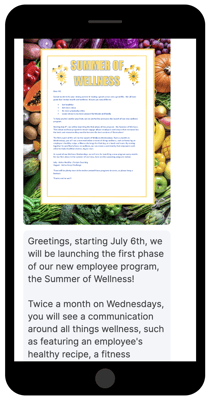
Safety
Safety should always be the first priority for frontline employees. The above example shows how one team uses goHappy to quickly inform staff of ongoing concerns related to the scorching heat and shares safety practices on how to protect themselves.
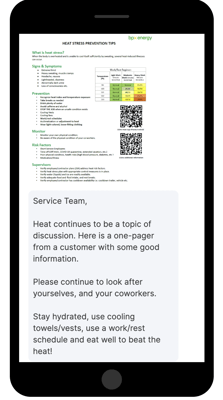
Sharing Time Sensitive Documents
Not all employee tasks can be completed on a cell phone. But just because your employees have to download a form, doesn't mean you have to send it via email. The above example shows how one team advises team members to download their W-2s for tax preparation with a simple, informative text.
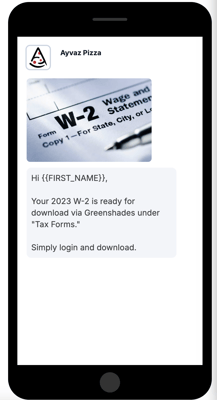
Rewards
Acting on employee feedback to uplevel benefit packages is a great move. But announcing the change in a medium where your frontline is most likely to see it? That’s a move after our own hearts. The above team acted on employee feedback to pilot a new parental leave program for salaried employees and chose goHappy to share the good news with employees in a snap.
.webp?width=219&height=400&name=queso(1).webp)
How to create your own frontline communications strategy
Looking to create a best-in-class communications strategy for your frontline? Here are some of the crucial steps to follow.
Align on metrics
Key metrics in frontline employee communications include worker engagement, participation, satisfaction, feedback rates, and productivity. Tracking these metrics helps determine if you're getting through to your team and provides deep insights to help you optimize your strategy for maximum results. Innovative solutions such as goHappy provide real-time analytics to help you track various analytics. They also feature advanced capabilities to help you automate and personalize your messages to fit your needs.
Create a content calendar
Creating a content calendar for your frontline messages removes the guesswork from the task. It lets you align on the topics you'll address during specific periods, keep your messages fresh, and align outreach to your larger engagement goals. You can build your content around company priorities, HR updates, events, holidays, and more.
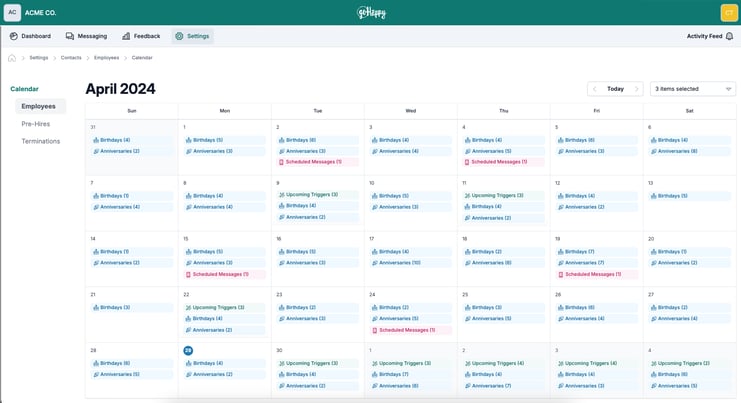
Benchmark engagement
Without measurement, nothing can really be improved—and employee engagement is no different. Benchmark data reveals your company's strengths and shortcomings when engaging employees, allowing you to prioritize the most crucial areas for improvement. Engagement matters because it correlates with positive outcomes for your business. For example, goHappy partner Breeze Thru Car Wash saw a 29% decrease in turnover after a 17% increase in employee engagement.
Employee communications FAQ
What is effective communication with employees?
Communicating effectively with your employees goes beyond relaying the message—it should ensure you're heard and understood. One-way messages are effective for making announcements, providing updates, or sending reminders. But communication with your employees should also provide space for the crucial feedback you need to improve engagement.
What is the most common type of communication in the workplace?
There's no one-size-fits-all workplace communication solution—it comes down to the composition of your team. An intuitive, text-based solution can help you overcome hurdles and effectively communicate with your frontline employees.
How do you know your employer communications are effective?
Soliciting feedback is the only way to determine the efficiency of your employer communication—what gets measured gets managed. You can use pulse surveys or goHappy's engagement and feedback solutions for frontline feedback. These innovative solutions let you tailor your communication strategy to suit your needs and feature advanced analytic capabilities. You can use various metrics to measure the efficacy of each strategy and make informed decisions.
Level Up Your Frontline Communications in 2025
goHappy helps managers and HR teams keep a finger on the pulse of their frontline employees, driving better results for employees, customers, and your business.
Ready to streamline your frontline employee communication in 2025? Learn more about our frontline messaging solutions.



.png)



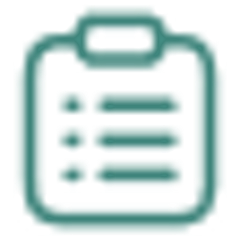



.webp)
.png)